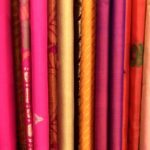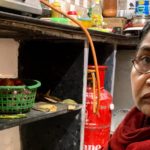How do you gauge the quality of a Chanderi saree? One way is through the quality of the buttis. Are they simple or complicated? Are they big or small (small is generally harder to do, unless it is a simple design). Below are some buttis that will explain this process. Thank you, Aswin Gopilal of Gopilal & Sons, Chanderi for explaining the process. Thank you, Dikshita Pant of Taneira for enhancing the explanation.
Eknaliya buttis are a single thread of extra weft, then a single ground weft, then a single thread of extra weft and so on. Because the weave is very tight, the motif is enhanced. Plus, it is made from a single thread which is hard.
Donaliya is easier than an eknaliya. It is a single extra weft, two ground wefts, then a single extra weft, and so on. The butti is not packed as tight. The same butti will take half the amount of time in a donaliya as compared to an eknaliya.
Do Chashme is a reversible saree. The border is a reversible border made with a double dobby design. The design is woven on both sides. It was traditionally woven for Gwalior royalty who wore the saree folded in between the legs, like a kache. So when it was tucked in the back (like a Maharashtrian navvari or a South Indian kache), the back of the border was just as beautiful. Like we said, the border is finished on both sides.
Mehndi lage haath: in which the hands of a bride with henna are woven into the saree
Sada Suhagan: in which these words are woven into the saree in Hindi.
Doli baraat: gifted to the bride to be.
Rani haar: depiction of the neckpiece in the saree




